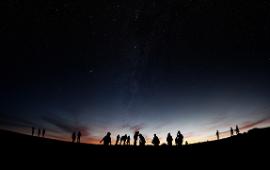December Media and Swinburne release The Search for Life in Space

In Summary
- December Media produced The Search for Life in Space in collaboration with Swinburne
- The film focuses on the search for life on worlds that exhibit similar evolutionary processes to Earth
- The film opens 16 March at IMAX® Melbourne
Taking viewers from the surface of Mars and the icy moons of Jupiter and Saturn to the extreme lava fields and toxic thermal vents under the ocean, the new IMAX® film The Search for Life in Space is not to be missed.
The film is the second in a trilogy developed by December Media in collaboration with Swinburne. The first film, Hidden Universe, shows us how technology allows us to look further into space.
The Search for Life in Space uses the technology explored in the first film to search for life on worlds that exhibit similar evolutionary processes to Earth. The live action sequences were shot in Hawaii, due to the wide range of climate types there.
The film has a strong focus on astrobiology, a relatively new field that looks at the origin, survival, and possible distribution of life around the Universe.
Astrobiologists analyse Earth’s own evolution to consider how life has formed and sustained itself. This information is then used to search for moons and planets that are most likely to be able to host life.
"In showing to us the beauty of space The Search For Life In Space reminds us of why we explore but it's in the breathtaking journey on Earth that we understand the value of that life," says Swinburne Associate Professor Alan Duffy.
"I have never been more in awe of our Solar System than when I got to soar alongside spacecraft over planets like Saturn and Jupiter. Knowing it's scientifically accurate just makes the experience all the more astounding."
Viewers will be able to immerse themselves in outer space, as the film features images taken by the world’s most powerful telescopes.
Making space images for the giant screen
The film's visual effects team used supercomputers at Swinburne's Centre for Astrophysics and Supercomputing to render the images.
Rendering the images required a tremendous amount of computing power as well as more than 500 terabytes of disk space.
“A frame takes more than 16 times longer to render than a typical TV frame, plus a lot of extra development time to achieve enough detail in the scene to make it worthy of 8k,” animation producer and Swinburne multimedia alumnus Russell Scott says.
“We ran a broad range of software, including 3ds Max, V-Ray, DaVinci Resolve and Blackmagic Design: Fusion as well as custom tools and various plugins.”
The Swinburne team worked with advising physicists and astronomers over 12 months to render the space images.
“There are few people in Australia, let alone the world, who could have achieved this film and we were very fortunate to have such excellent support from the IT team at Swinburne,” Mr Scott says.
The next film in the series, Earth Story, will take us into the visual journey of our planet’s birth, infancy and adolescence.
Check session times for The Search for Life in Space at IMAX® Melbourne.
IMAX® is a trademark of IMAX Corporation.

